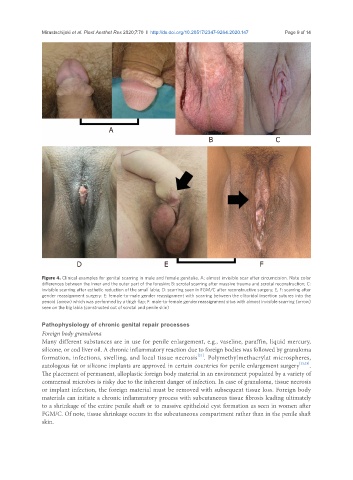Page 833 - Read Online
P. 833
Mirastschijski et al. Plast Aesthet Res 2020;7:70 I http://dx.doi.org/10.20517/2347-9264.2020.147 Page 9 of 14
A
B C
D E F
Figure 4. Clinical examples for genital scarring in male and female genitalia. A: almost invisible scar after circumcision. Note color
differences between the inner and the outer part of the foreskin; B: scrotal scarring after massive trauma and scrotal reconstruction; C:
invisible scarring after esthetic reduction of the small labia; D: scarring seen in FGM/C after reconstructive surgery; E, F: scarring after
gender reassignment surgery: E: female-to-male gender reassignment with scarring between the clitoridal insertion sutures into the
penoid (arrow) which was performed by a thigh flap; F: male-to-female gender reassignment situs with almost invisible scarring (arrow)
seen on the big labia (constructed out of scrotal and penile skin)
Pathophysiology of chronic genital repair processes
Foreign body granuloma
Many different substances are in use for penile enlargement, e.g., vaseline, paraffin, liquid mercury,
silicone, or cod liver oil. A chronic inflammatory reaction due to foreign bodies was followed by granuloma
[21]
formation, infections, swelling, and local tissue necrosis . Polymethylmethacrylat microspheres,
autologous fat or silicone implants are approved in certain countries for penile enlargement surgery [22,23] .
The placement of permanent, alloplastic foreign body material in an environment populated by a variety of
commensal microbes is risky due to the inherent danger of infection. In case of granuloma, tissue necrosis
or implant infection, the foreign material must be removed with subsequent tissue loss. Foreign body
materials can initiate a chronic inflammatory process with subcutaneous tissue fibrosis leading ultimately
to a shrinkage of the entire penile shaft or to massive epitheloid cyst formation as seen in women after
FGM/C. Of note, tissue shrinkage occurs in the subcutaneous compartment rather than in the penile shaft
skin.

